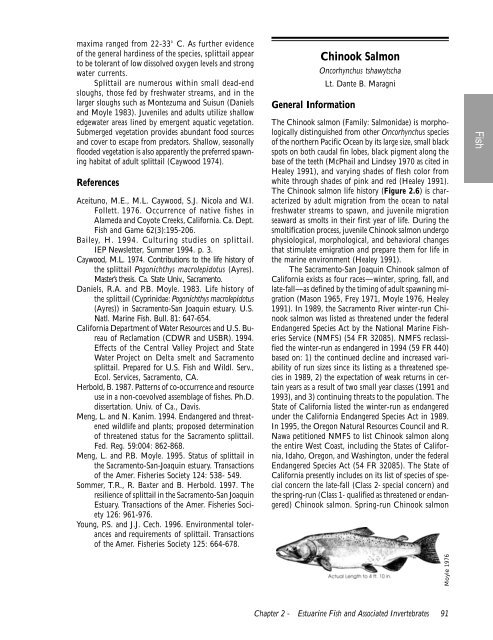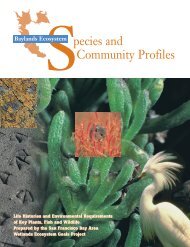Species and Community Profiles - San Francisco Estuary ...
Species and Community Profiles - San Francisco Estuary ...
Species and Community Profiles - San Francisco Estuary ...
You also want an ePaper? Increase the reach of your titles
YUMPU automatically turns print PDFs into web optimized ePapers that Google loves.
maxima ranged from 22-33° C. As further evidence<br />
of the general hardiness of the species, splittail appear<br />
to be tolerant of low dissolved oxygen levels <strong>and</strong> strong<br />
water currents.<br />
Splittail are numerous within small dead-end<br />
sloughs, those fed by freshwater streams, <strong>and</strong> in the<br />
larger sloughs such as Montezuma <strong>and</strong> Suisun (Daniels<br />
<strong>and</strong> Moyle 1983). Juveniles <strong>and</strong> adults utilize shallow<br />
edgewater areas lined by emergent aquatic vegetation.<br />
Submerged vegetation provides abundant food sources<br />
<strong>and</strong> cover to escape from predators. Shallow, seasonally<br />
flooded vegetation is also apparently the preferred spawning<br />
habitat of adult splittail (Caywood 1974).<br />
References<br />
Aceituno, M.E., M.L. Caywood, S.J. Nicola <strong>and</strong> W.I.<br />
Follett. 1976. Occurrence of native fishes in<br />
Alameda <strong>and</strong> Coyote Creeks, California. Ca. Dept.<br />
Fish <strong>and</strong> Game 62(3):195-206.<br />
Bailey, H. 1994. Culturing studies on splittail.<br />
IEP Newsletter, Summer 1994. p. 3.<br />
Caywood, M.L. 1974. Contributions to the life history of<br />
the splittail Pogonichthys macrolepidotus (Ayres).<br />
Master’s thesis. Ca. State Univ., Sacramento.<br />
Daniels, R.A. <strong>and</strong> P.B. Moyle. 1983. Life history of<br />
the splittail (Cyprinidae: Pogonichthys macrolepidotus<br />
(Ayres)) in Sacramento-<strong>San</strong> Joaquin estuary. U.S.<br />
Natl. Marine Fish. Bull. 81: 647-654.<br />
California Department of Water Resources <strong>and</strong> U.S. Bureau<br />
of Reclamation (CDWR <strong>and</strong> USBR). 1994.<br />
Effects of the Central Valley Project <strong>and</strong> State<br />
Water Project on Delta smelt <strong>and</strong> Sacramento<br />
splittail. Prepared for U.S. Fish <strong>and</strong> Wildl. Serv.,<br />
Ecol. Services, Sacramento, CA.<br />
Herbold, B. 1987. Patterns of co-occurrence <strong>and</strong> resource<br />
use in a non-coevolved assemblage of fishes. Ph.D.<br />
dissertation. Univ. of Ca., Davis.<br />
Meng, L. <strong>and</strong> N. Kanim. 1994. Endangered <strong>and</strong> threatened<br />
wildlife <strong>and</strong> plants; proposed determination<br />
of threatened status for the Sacramento splittail.<br />
Fed. Reg. 59:004: 862-868.<br />
Meng, L. <strong>and</strong> P.B. Moyle. 1995. Status of splittail in<br />
the Sacramento-<strong>San</strong>-Joaquin estuary. Transactions<br />
of the Amer. Fisheries Society 124: 538- 549.<br />
Sommer, T.R., R. Baxter <strong>and</strong> B. Herbold. 1997. The<br />
resilience of splittail in the Sacramento-<strong>San</strong> Joaquin<br />
<strong>Estuary</strong>. Transactions of the Amer. Fisheries Society<br />
126: 961-976.<br />
Young, P.S. <strong>and</strong> J.J. Cech. 1996. Environmental tolerances<br />
<strong>and</strong> requirements of splittail. Transactions<br />
of the Amer. Fisheries Society 125: 664-678.<br />
General Information<br />
Chinook Salmon<br />
Oncorhynchus tshawytscha<br />
Lt. Dante B. Maragni<br />
The Chinook salmon (Family: Salmonidae) is morphologically<br />
distinguished from other Oncorhynchus species<br />
of the northern Pacific Ocean by its large size, small black<br />
spots on both caudal fin lobes, black pigment along the<br />
base of the teeth (McPhail <strong>and</strong> Lindsey 1970 as cited in<br />
Healey 1991), <strong>and</strong> varying shades of flesh color from<br />
white through shades of pink <strong>and</strong> red (Healey 1991).<br />
The Chinook salmon life history (Figure 2.6) is characterized<br />
by adult migration from the ocean to natal<br />
freshwater streams to spawn, <strong>and</strong> juvenile migration<br />
seaward as smolts in their first year of life. During the<br />
smoltification process, juvenile Chinook salmon undergo<br />
physiological, morphological, <strong>and</strong> behavioral changes<br />
that stimulate emigration <strong>and</strong> prepare them for life in<br />
the marine environment (Healey 1991).<br />
The Sacramento-<strong>San</strong> Joaquin Chinook salmon of<br />
California exists as four races—winter, spring, fall, <strong>and</strong><br />
late-fall—as defined by the timing of adult spawning migration<br />
(Mason 1965, Frey 1971, Moyle 1976, Healey<br />
1991). In 1989, the Sacramento River winter-run Chinook<br />
salmon was listed as threatened under the federal<br />
Endangered <strong>Species</strong> Act by the National Marine Fisheries<br />
Service (NMFS) (54 FR 32085). NMFS reclassified<br />
the winter-run as endangered in 1994 (59 FR 440)<br />
based on: 1) the continued decline <strong>and</strong> increased variability<br />
of run sizes since its listing as a threatened species<br />
in 1989, 2) the expectation of weak returns in certain<br />
years as a result of two small year classes (1991 <strong>and</strong><br />
1993), <strong>and</strong> 3) continuing threats to the population. The<br />
State of California listed the winter-run as endangered<br />
under the California Endangered <strong>Species</strong> Act in 1989.<br />
In 1995, the Oregon Natural Resources Council <strong>and</strong> R.<br />
Nawa petitioned NMFS to list Chinook salmon along<br />
the entire West Coast, including the States of California,<br />
Idaho, Oregon, <strong>and</strong> Washington, under the federal<br />
Endangered <strong>Species</strong> Act (54 FR 32085). The State of<br />
California presently includes on its list of species of special<br />
concern the late-fall (Class 2– special concern) <strong>and</strong><br />
the spring-run (Class 1– qualified as threatened or endangered)<br />
Chinook salmon. Spring-run Chinook salmon<br />
Chapter 2 — Estuarine Fish <strong>and</strong> Associated Invertebrates 91<br />
Moyle 1976<br />
Fish



